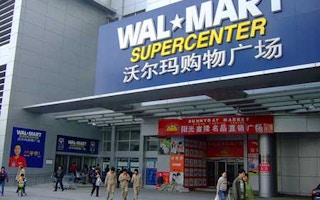Wal-Mart Stores Inc has given global suppliers five years to comply with its environmental rules or risk being pushed off US shelves at the world’s largest retailer, expanding a sustainability campaign launched in 2009.
The new requirements, announced in China where Wal-Mart has more than 20,000 suppliers, will compel workshops that churn out much of the world’s toys, clothing and electronics to improve on energy efficiency, waste reduction and other markers on the retailer’s checklist.
Wal-Mart said the checklist was voluntary. But if suppliers fall short, they could be cut off from the nearly 4,000 Walmart discount stores and more than 600 Sam’s Club wholesale warehouses that the company operates in the United States.
The standards set in Wal-Mart’s “sustainability index”, which has helped to burnish an image tarnished by criticism from labor groups and local communities, have already been embraced by 500 of the world’s major consumer product makers.
The retailer said that by the end of 2017, US Walmart and Sam’s Club stores will get 70 per cent of their goods from global suppliers that use the sustainability index.
“This will send a clear message to the Walmart supply chain that if you want to grow and partner with us for the long term, you will engage with us on the sustainability index,” Wal-Mart Chief Executive Mike Duke said in a speech in Beijing, a copy of which was provided to Reuters in advance.
Toy story
Wal-Mart comes in at No. 99 on Newsweek’s annual environmental ranking of the world’s 500 biggest publicly traded companies, trailing six other retailers but coming in just ahead of its closest competitor, France’s Carrefour SA.
Wal-Mart has pushed suppliers to cut down on packaging, water usage and energy consumption, in part because it cuts costs.
It launched the sustainability index in July 2009, saying it would eventually be used in ratings that let consumers judge how green a product is.
The company is a frequent target of labor groups who say it pays poverty-level wages at its US stores and drives small competitors out of business, but it has earned praise from environmental groups for its green efforts.
Environmental group Greenpeace, though, said Wal-Mart’s “humongous supply chain is still far from clean” and urged the company to address more issues such as deforestation and the use of pesticides and chemical fertilizers in its fresh produce.
Its China ties have also drawn scrutiny. Wal-Mart was among the pioneers in buying from China after it joined the World Trade Organisation in 2001, which helped drive down prices in Wal-Mart’s stores but added to the US trade deficit and left the company open to complaints that it was hurting US jobs.
Wal-Mart said as recently as 2008 that it directly exported about $9 billion a year out of China, and third-party suppliers shipped another $9 billion, although it no longer provides that information on its website.
A 2007 study by the US-based think tank Economic Policy Institute estimated that the retailer alone accounted for 11 percent of the growth in the US-China trade gap between 2001 and 2006.
Because of its size - Wal-Mart’s global sales are nearly quadruple those of the world’s No. 2 retailer, Carrefour - its environmental rules can have an outsized impact when filtered through its tens of thousands of suppliers.
Wal-Mart registered some $65 billion in second-quarter sales at its namesake US stores, accounting for about 7 cents out of every retail dollar spent in the United States, excluding autos.
But it is also legendary for pressuring suppliers to cut prices, and that can make it hard for smaller firms to get greener. While reducing energy usage saves money, if it requires retrofitting then the initial investment may be large.
Wal-Mart said its index covers 107 product categories such as apparel, electronics and toys. It asked its buyers to use the index to choose suppliers and set conditions.
The company has been seeking ways that help to save energy or otherwise sustain its people and the environment but without raising prices for its cost-conscious customers.
A Wal-Mart executive told Reuters in September that the retailer had asked computer makers to shorten the default time before their laptops and PCs lapse into sleep mode, cutting it to five minutes from the standard 30 minutes.
Duke said the retailer’s toy buyers visited Chinese factories recently “with the index in hand” to judge energy usage and check on whether the plastics used in the toys were safe for factory workers and their communities.
“The index is providing us with a full picture of the sustainability of products - from social to environmental issues, from the impact on workers to the impact on the planet,” Duke said.










